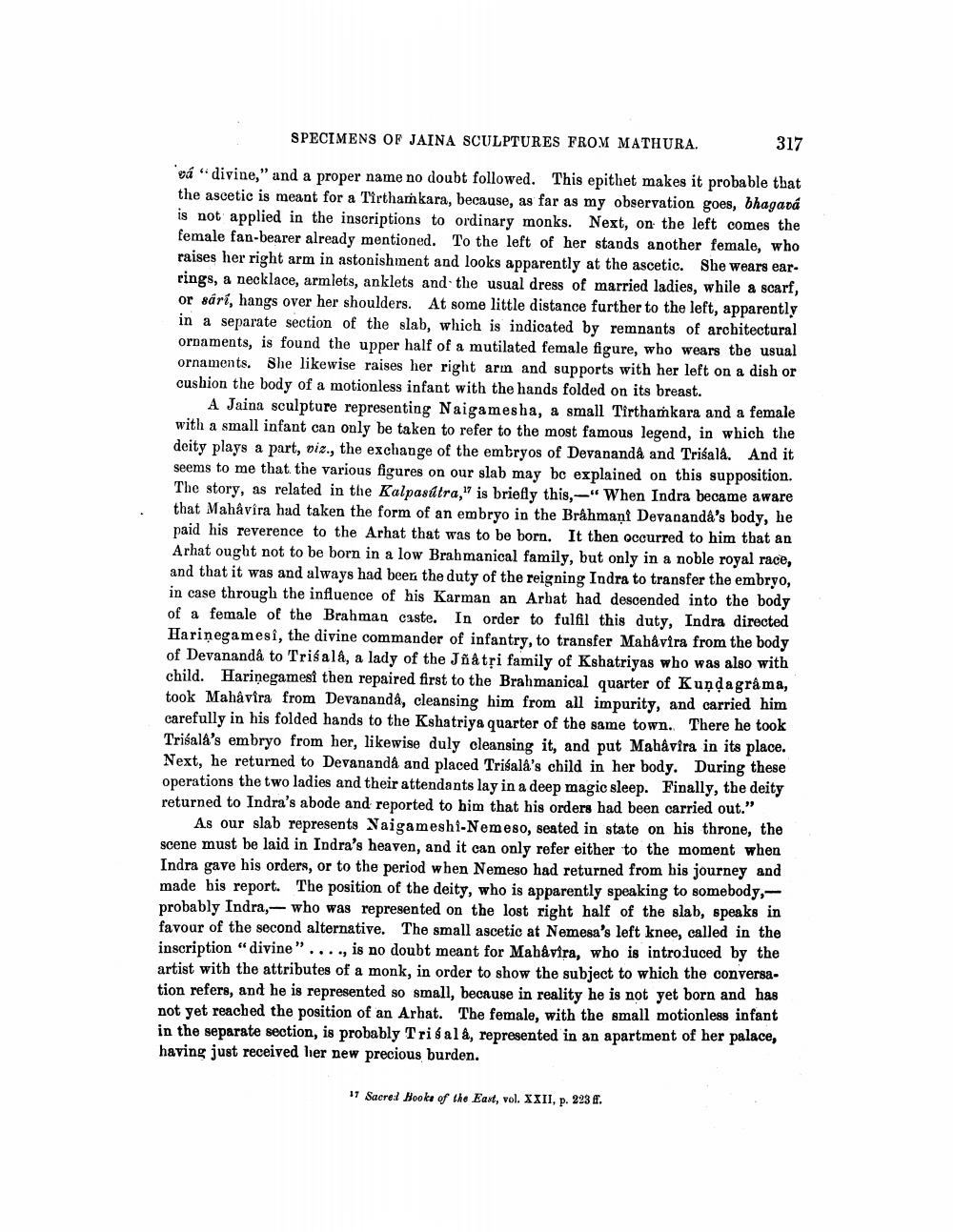________________
SPECIMENS OF JAINA SCULPTURES FROM MATHURA.
317
vá "divine," and a proper name no doubt followed. This epithet makes it probable that the ascetic is meant for a Tirthamkara, because, as far as my observation goes, bhagadá is not applied in the inscriptions to ordinary monks. Next, on the left comes the female fan-bearer already mentioned. To the left of her stands another female, who raises her right arm in astonishment and looks apparently at the ascetic. She wears ear. rings, a necklace, armlets, anklets and the usual dress of married ladies, while a scarf, or sárí, hangs over her shoulders. At some little distance further to the left, apparently in a separate section of the slab, which is indicated by remnants of architectural ornaments, is found the upper half of a mutilated female figure, who wears the usual ornaments. She likewise raises her right arm and supports with her left on a dish or cushion the body of a motionless infant with the hands folded on its breast.
A Jaina sculpture representing Naigamesha, a small Tirthamkara and a female with a small infant can only be taken to refer to the most famous legend, in which the deity plays a part, vix, the exchange of the embryos of Devananda and Trišala. And it seems to me that the various figures on our slab may be explained on this supposition. The story, as related in the Kalpasútra, is briefly this,-" When Indra became aware that Mahavira had taken the form of an embryo in the Brahmani Devananda's body, he paid his reverence to the Arhat that was to be born. It then occurred to him that an Arhat ought not to be born in a low Brahmanical family, but only in a noble royal race, and that it was and always had been the duty of the reigning Indra to transfer the embryo, in case through the influence of his Karman an Arbat had descended into the body of a female of the Brahman caste. In order to fulfil this duty, Indra directed Harinegamesi, the divine commander of infantry, to transfer Mahåvira from the body of Devananda to Trisala, a lady of the Jñâtsi family of Kshatriyas who was also with child. Harinegamest then repaired first to the Brahmanical quarter of Kundagrama, took Mahavira from Devananda, cleansing him from all impurity, and carried him carefully in his folded hands to the Kshatriya quarter of the same town. There he took Trisala's embryo from her, likewise duly cleansing it, and put Mahavira in its place. Next, he returned to Devananda and placed Tribala's child in her body. During these operations the two ladies and their attendants lay in a deep magic sleep. Finally, the deity returned to Indra's abode and reported to him that his orders had been carried out."
As our slab represents Waigameshi-Nemeso, seated in state on his throne, the scene must be laid in Indra's heaven, and it can only refer either to the moment when Indra gave his orders, or to the period when Nemeso had returned from his journey and made his report. The position of the deity, who is apparently speaking to somebody,probably Indra, who was represented on the lost right half of the slab, speaks in favour of the second alternative. The small ascetic at Nemesa's left knee, called in the inscription "divine"...., is no doubt meant for Mab&vira, who is introduced by the artist with the attributes of a monk, in order to show the subject to which the conversation refers, and he is represented so small, because in reality he is not yet born and has not yet reached the position of an Arhat. The female, with the small motionless infant in the separate section, is probably Tribala, represented in an apartment of her palace, having just received her new precious burden.
17 Sacreal Book of the East, vol. XXII, p. 223 ff.




